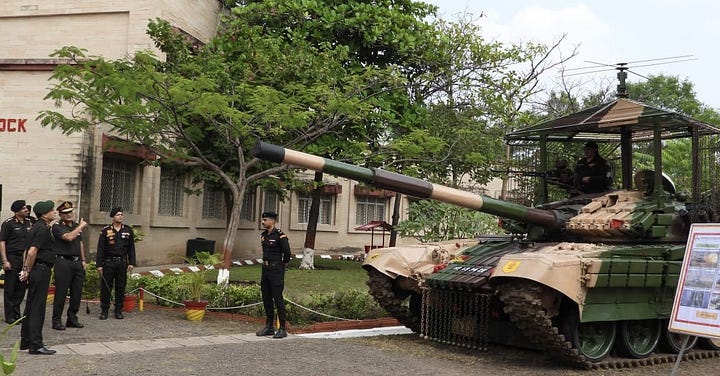India And Pakistan Quietly Prepare Ground Forces To Face Armed "FPV" Drones
🇮🇳 🇵🇰 Minimal Comment
Minimal comment-themed posts are used to introduce data points for use in other posts going forward. Posts of this theme will typically feature minimal analysis and commentary.
Observers of military dynamics in South Asia will have likely noticed the steadily increasing prevalence of not just multirotor drones, including armed multirotor drones, in the images and videos released by the Indian and Pakistani military, but also the steadily increasing prevalence of images and videos that show the development and deployment of countermeasures thereto. Consider, for example, the following recently released images of Indian tanks that are equipped with additional armour that is primarily intended to counter multirotor drone-dropped munitions.


While so far primarily associated with the Russia-Ukraine War, there is no reason to assume that armed multirotor drones, including those of the so-called “first-person video” (“FPV”) variety, cannot or will not proliferate elsewhere, including South Asia. Indeed, such proliferation has been well underway for several years, and both the Indian and Pakistani militaries are actively preparing for the large-scale employment of such uncrewed aircraft-turned-munitions.
One of the key challenges that both India and Pakistan face is that the vast majority of armoured combat vehicles that exist in South Asia are poorly positioned to withstand the potent all-aspect threat posed by the combination of multirotor drones and shaped charge warheads. This includes the predominantly Soviet-derived tanks operated by both India and Pakistan, which are reflective of a design philosophy which, among other things, was more suitable in a now bygone era in which threats to armoured vehicles primarily impacted the frontal aspect. Simply stated, essentially every armoured combat vehicle that is presently in the service of the Indian and Pakistani militaries is a veritable death trap should these be used against an opponent that is equipped with the (fairly basic) quality and, more importantly, quantity of armed “FPV” multirotor drones operated by both Russia and Ukraine. Given this, the current South Asian military dynamic is one in which both India and Pakistan are likely to be subject to extremely high and ultimately unsustainable vehicular losses and associated casualties among the crew and embarked personnel.
Observers should bear in mind dynamic is unlikely to change for at least a decade or more, given the very large numbers of new, better-equipped and more heavily armoured vehicles that will be required to complement and ultimately replace the existing fleets of predominantly poorly protected—relative to current and fast-emerging threats—of armoured combat vehicles. This dynamic is likely to have implications far beyond the narrow area of ground combat capabilities. It may, for example, result in both India and Pakistan placing greater emphasis on long-range “standoff” capabilities in an environment in which first Pakistani “tactical” nuclear weapons and now the all-aspect shaped charge threat are making high-intensity large-scale ground combat operations ever less viable in South Asia.

